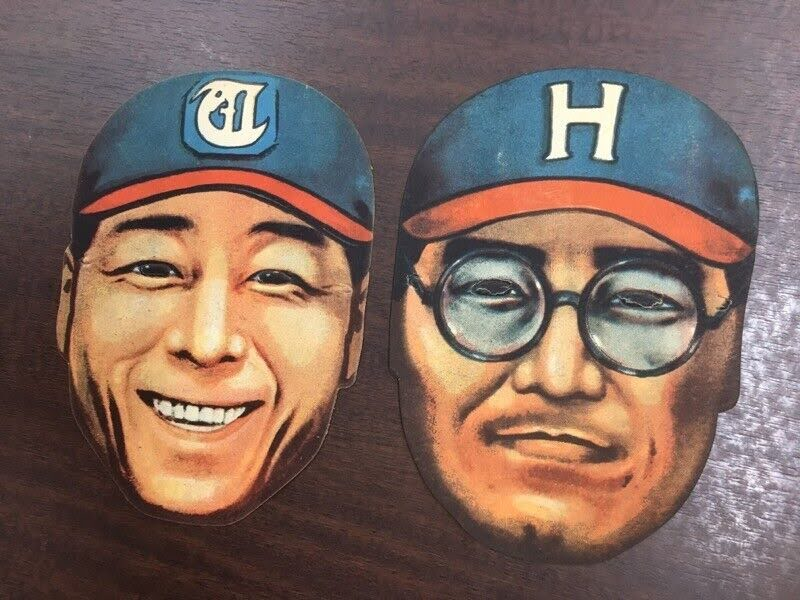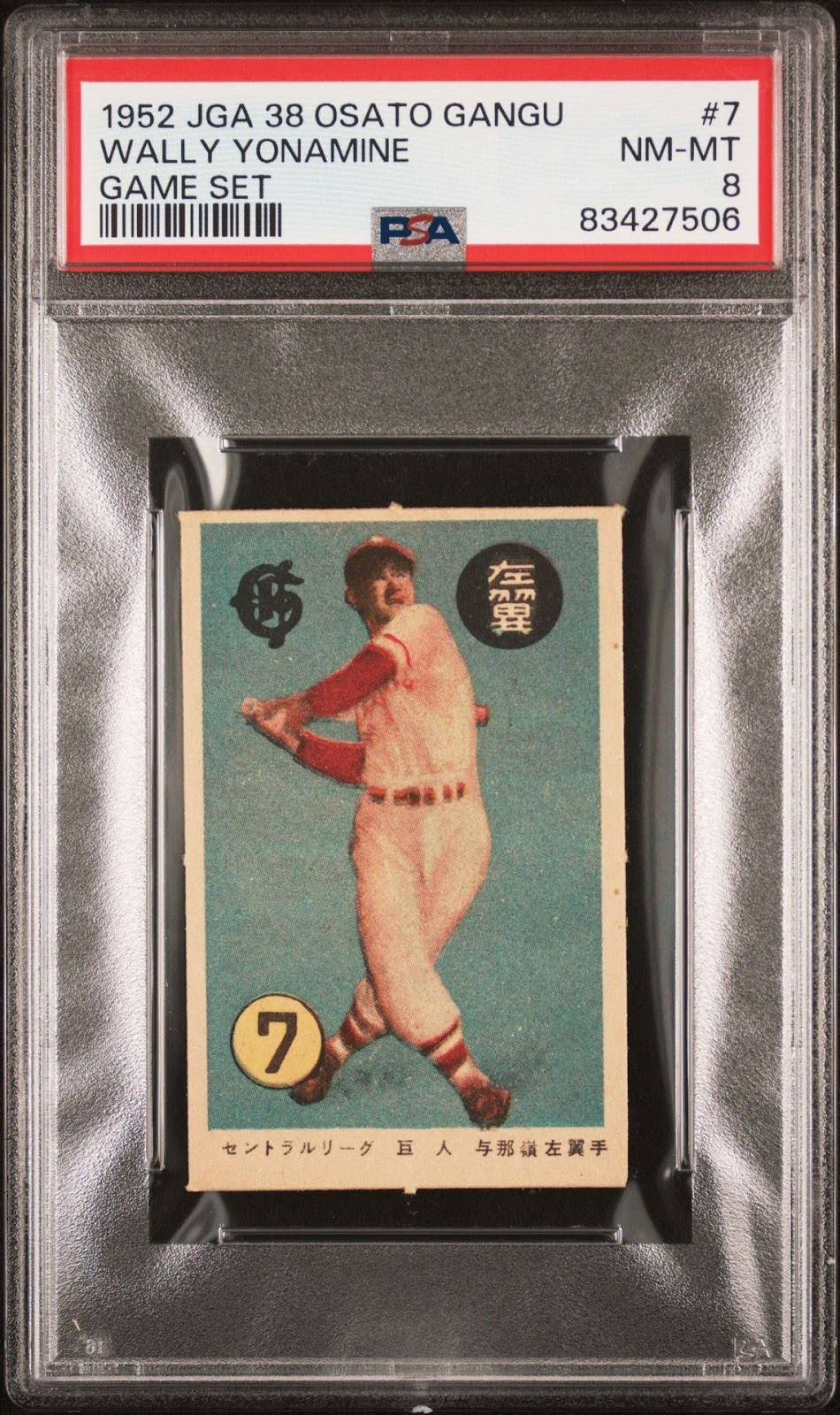Next year, the National Baseball Hall of Fame will almost certainly induct its first Japanese baseball player when Ichiro enters. Considering Japan's rich baseball history, Ichiro’s long-awaited induction is surprising.
The game was introduced to Japan in 1872, and professional leagues were established by the 1920’s. About 100 years later, Japan will have its first member in Cooperstown.
Other Japanese players could have had Hall of Fame careers in America. For whatever reason, they either never got or had a desire to showcase their skills in the majors.
The entire JDM2: 1949 Mask Set. Photo provided by Jeff in Tokyo
But whether it’s in the U.S. or Asia, baseball is a game that honors its statistics and history unlike any other. The history explains why records are so revered and why Honus Wagner and Mickey Mantle trading cards - mere mementos - are worth millions.
Japan has a proud baseball history and its fair share of legends. For the collector, Japanese baseball cards - especially vintage ones - are like opening a hatch and jumping into a new realm.
Menkos from the writer’s collection. Part of the 1948 JRM 26 set.
According to Gary Engel’s Japanese Vintage Baseball Card Checklist & Price Guide, vintage cards are considered as cards produced before 1991. Engel is regarded as the godfather of collecting for Japanese baseball cards.
What Jefferson Burdick was to tobacco cards, Engel is to vintage Japanese baseball. Engel not only cataloged and classified the vintage cards in a way that had never been done before, but he also regularly priced them out. In that regard, he is also like Dr. James Beckett.
On the other hand, I know very little about Japanese baseball cards. But I wanted passionate collectors to talk about the cards they love. Often, one person’s passion can spark someone else’s. In the following sections, collectors of vintage Japanese baseball cards share their favorite sets with admiration and love for the hobby that brings the cards to life.
All of the collectors featured below are worth a follow if you want to learn about Japanese baseball history, dip your toes into vintage Japanese baseball cards and memorabilia, or look for some enjoyable storytelling. We start off with Jeff in Tokyo, from whom I bought my first set of vintage Japanese baseball called Menkos.
Jeff in Tokyo, Vintage Japanese Baseball Dealer in Japan My favorite vintage set is the JDM2: 1949 Mask Diecuts. The main reason is that these cards are pretty unique. Look at them. The artwork is beautiful.
I should also mention that because a decent amount of deadstock has been found, they are surprisingly affordable.
Hiroshi Ohshita (left) and Jjiro Noguchi (right). Both NPB Hall of Famers.
As for personal significance, around 28 years ago I was one of the collectors who found an antique store that had a whole bunch of them. I was able to sell and trade a bunch to fellow collectors, so that was cool. Recently, there was another bunch found, so prices right now are low but there will always be demand for it.
My favorite card in the set is simple. I wrote to Kaoru Betto (Nippon Pro Baseball Hall of Famer) before he passed and he very kindly signed one of the masks in both Japanese and English. To me, this is one of the coolest cards in the world. Maybe not the most valuable but the coolest.
“Kaoru Betto in all his glory!” - Jeff
Dave McNeely, Writer of JapaneseBaseballCards.blogspot.com
I’m going to cheat a little bit as my favorite set is actually a group of sets - the Yamakatsu sets from the mid to late 1970’s. They’re a bit confusing but Yamakatsu issued something like 15 base sets plus 5 “premium” sets between 1976 and 1981.
The card sizes were all over the place with the first cards being 7 by 10 inches and later sets dropping in size to postcard size, roughly standard size and even lower. Some of the “premium” sets were huge - one set was 12 by 18 inches while another was 14 by 15 ½ inches.
Sadaharu Oh in a 1980 Yamakatsu release.
There are two things that make these sets favorites of mine. The first is that nearly all the sets used a “pure card” design that either had full bleed, borderless card fronts or, in some of the later issues, a small white border a la 1953 Bowman.
The second (and bigger reason) is that they feature great photography. There’s an amazing combination of both posed and action photos that I’m not sure has ever been matched in any other NPB sets. The photos really stand out on the larger cards.
NPB Hall of Famer Tsutomu Wakamatsu in a 1977 Yamakatsu release.
The sets include most of the big stars of the era such as Sadaharu Oh, Isao Harimoto, Yutaka Enatsu, Koji Yamamoto, Sachio Kinugasa, Hisashi Yamada, Koichi Tabuchi and Tsutomu Wakamatsu.
Since Lotte, a competing snack food manufacturer, wouldn’t let Calbee (potato chip manufacturer that distributes cards) do cards of any Orion players, the Yamakatsu sets are one of the few 70’s issues where you can find Orion stars like Choji Murata and Michiyo Arito.
Robert Klevens, Owner, Prestige Collectibles Auction
Over the past 35 years, I've come across a variety of Japanese card sets, but my absolute favorite is the recently acquired 1952 Osato Gangu complete 48-card set, found sealed in its original box. I was utterly astonished to come across a fully sealed set, as I had never encountered one previously. Before obtaining this set, my search efforts were limited to just a few singles.
This set holds the distinguished rarity of R5, as per Gary Engel's Japanese Vintage Baseball Card Checklist & Price Guide, denoting that there are fewer than 5 copies of each card currently known. Featuring four teams – the Giants, Hawks, Orions, and the Tigers – the set captivates me with its vivid color and thoughtful portrait design of each player. I particularly appreciate the inclusion of four umpires, including Hall of Famer Nobuaki Nidegawa.
Among the 16 Hall of Famers and a few American-born players, my favorite card showcases Hawaiian-born Japanese Hall of Famer Wally Yonamine, marking his second-year card as a Yomiuri Giants rookie in 1951. Having had the privilege of meeting Wally at his Tokyo pearl shop in the 1990s, anything associated with him holds special significance.
In addition to the cards, I find the box to be quite striking, featuring a full-color image of Hall of Famer Takehiko Bessho of the Yomiuri Giants. The same image was used on both the box and his card.
Securing a complete set from the 1950s isn't a common occurrence, so I decided to send it to PSA for encapsulation. I'm highly pleased with the results and have intentions to include it in the set registry in the future.
Sean McGinty, Writer of Baseballcardsinjapan.blogspot.com
Collecting it is like what collecting pre-war tobacco cards must have been like in the U.S. fifty years ago before the modern hobby changed everything.
First, it’s a challenge. It has 1472 cards (possibly the largest baseball card set ever produced), but they were sold in one-card packs with potato chips and many haven’t survived, while some series were only released regionally making them very rare.
Second, it won’t break the bank. The cards are hard to find (even living in Japan) but none of them are particularly expensive. The most I’ve spent on a single card is 70$, and most cost way less than that.
Most vintage US sets have a bottleneck for budget collectors – anyone wanting to put a 1952 Topps set together needs to buy a Mantle that costs more than a house now – but most old Japanese sets don’t pose that problem.
Partly this is because the hobby here in Japan still works like the U.S. market was a long time ago. Hardly anybody gets their cards graded (of 1472 cards in this set, only 240 have ever been graded by PSA), so the investment mindset doesn’t really exist with respect to them. Japanese collectors of these old Calbees are set-builders like me, working to a different tune.
Finally, the cards are beautiful. Compared to Topps sets from the mid-70s these win hands-down. They have full bleed photos, many of which feature fantastic action shots from regular season games played in the team’s regular stadiums (as opposed to Topps’ posed shots at spring training facilities).
You get a real sense of what the game was like back then when flipping through these. And it is full of cards featuring the big name greats of NPB – Sadaharu Oh, Isao Harimoto, Katsuya Nomura, Shigeo Nagashima and so on.
It’s a set that has grown on me over eleven years of actively collecting it. I can’t choose a favorite card, there are just too many good ones.
Andy Broome, Vice President, CGC Cards
I started collecting vintage Japanese baseball cards in the late 1990s. I was, and still to this day, focused on one Japanese player in particular, Victor Starffin.
While I do collect other Japanese cards, my focus is Starffin. Because of this, I don’t really collect vintage Japanese sets. But since Victor was a very popular player in his day, he is featured in a large number of sets from 1946-ish up until his last season of 1955.
Through collecting Starffin, I get to see a wide variety of different sets from menkos to bromides and all types of gaming and die-cut cards.
If I had to pick one set as my ‘favorite,’ I would have to pick a color bromide set from the late 40s/early 50s era. I believe bromide cards from this period are heavily influenced by US cards of this period.
This connection is not a stretch as these cards were produced during the US occupation of Japan following WWII. Two things that benefited from the US occupation were manga (comics) and baseball cards.
And if I had to narrow down the list to a specific color bromide set, it would be the 1950 JBR 89 color bromide with handwriting font as my favorite.
I love this set because of its beautiful simplicity. The cards are small (2” x 2-3/4”) and are printed on a bright white stock. The whiteness of the stock helps to make the almost pastel colors of the image pop. Couple this with the basic caption on the cards, and you are left with a classic card design.
If you were to translate the caption to English, you would see how these cards resemble a well-known and heavily collected US set, the T206 Monster. The captions include the player’s position, surname and team name. The overall look is clean and simple, much like T206 cards.
The backs are blank, like most vintage Japanese bromide cards are.
For many years, this set was a mystery to me. I had acquired the Starffin card in the early 2000s but it was some time before I discovered what this set was. Even after the set was cataloged by Gary Engel and Robert Klevens, the Starffin card remained elusive. Since that time, I now own 3 copies of the Starffin card from this set.













Comments